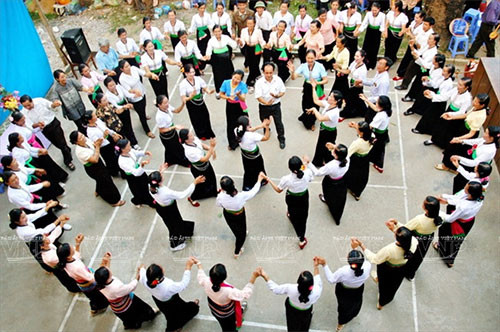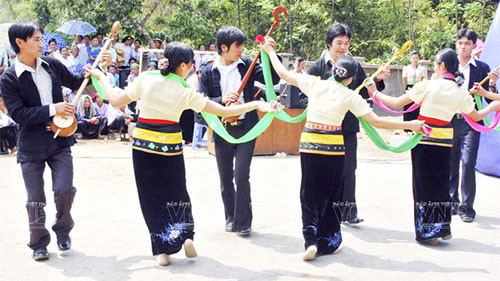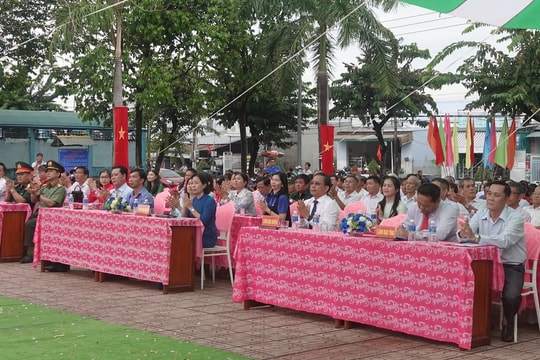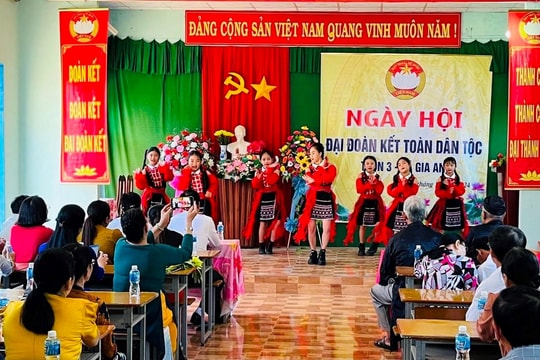 |
| Following gentle and alluring rhythms, Xoe dancers usually form a circle and move to the sound of melodic traditional music (Photo: Vietnam Pictorial). |
The Centre for Culture, Cinematography and Arts under the Dien Bien provincial Department of Culture, Sports and Tourism, recently held a class on ancient Xoe dances, attracting nearly 300 Thai locals in the province. It received much appreciation and applause from members of the art club for elders in Na Lay ward, Muong Lay town.
Lo Thi La, head of the club, said that despite having a passion for Xoe dance since she was a little girl, it wasn’t until now she had a chance to receive such methodology and official training on the folklore art form.
When she was a teenager, La was excited about village’s festivals when grandmothers and mothers dress in their most beautiful outfits to join the Xoe dance. Although she didn’t fully understand the origin and the meaning of the dance at that time, it brought her a lot of joy to see people holding hands in a big circle and dancing together.
Joining La at the class also included Lo Xuan Truong, a young Thai ethnic man from Banh village, Thanh Xuong commune, Dien Bien district. Truong said that the course helped him learn more about ancient Xoe dance and fuel his love for his tribe’s valuable culture. He was also motivated to introduce the art form to his friends and visitors to his village.
According to Thai ethnic artisan Lu Thi Hien, Xoe dance dates back to an old practice when Thai people held hands together to form a circle to ward off wild animals and dispel fear. The strength of solidarity united them into a group, a community that chases away wild beasts and conquers invaders.
Hien said she is happy that the Xoe dance is not only practiced by the Thai ethnic community but also other ethnic groups.
It was the second time Nguyen Thi Thanh Duong, Deputy Director of the Centre for Culture, Cinematography and Arts, has been entrusted to organise the class on the Xoe dance.
During her dozens of years working in the art, Huong has staged many arts programmes, showing her no matter what the space and occasion are, the Xoe dance also works well to unite participants together and fill the atmosphere with wonderful joy. She always scripted the Xoe dance as the concluding performance of the programmes.
 |
| As a folklore dance of the Thai ethnic group, Xoe is a cultural symbol of people in the north-western region. (Photo: Vietnam Pictorial) |
Mao Et, one of a few enthusiasts of Thai ethnic culture in Dien Bien, said that the Xoe dance is often accompanied with a drum, two or three gongs, a pair of cymbals, and several bamboo tubes. In some places, performers also utilise flutes and panpipes during the dance.
Although the melodies and rhythm of the music for the dance are simple and repetitive, it can generate a powerful sense of appeal among attendants.
Since 2016 when the Ministry of Culture, Sports and Tourism issued a decision on building a dossier on the Xoe Thai dance to seek the UNESCO title as an Intangible Cultural Heritage of Humanity, tremendous effort has been made by the Dien Bien provincial authorities, cultural sector, and Thai ethnic community to conduct research and preserve and hand down the practice to younger generations.
Accordingly, two classes on Xoe Thai dance were held in 2019 and 2020, drawing positive participation and an enthusiastic response from learners.
The local cultural sector has also integrated the Xoe Thai dance into its cultural events and festivals as a way to popularise the dance among the public and raise their awareness of the traditional intangible cultural heritage.
As a folklore dance of the Thai ethnic group, Xoe is a cultural symbol of people in the north-western region. Following gentle and alluring rhythms, dancers usually form a circle around a festive flame and move to the sound of melodic traditional music.
It is said that there are about 30 Xoe dances, but only six of them are most practiced in today’s life, including kham khen (holding hands), don hon (step up and down), pha xi (four-step dance), nhom khan (dance with a scarf), kham khan moi lau (making a toast), and om lom top mu (clapping hands while dancing in a circle).
Source: NDO



.jpg)



















.jpeg)

.jpeg)


.jpeg)


